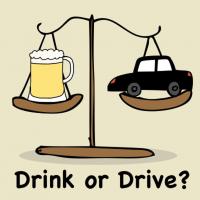Drunk driving kills and injures hundreds of thousands of people every year. This carnage could be stopped if more people knew about naltrexone, an FDA-approved medicine that reduces craving for alcohol.

Drinking and driving has profound, life-changing consequences for drunk drivers, their families, and their communities.
The medical profession has been slow to deliver solutions that help combat alcohol use disorder. This would be understandable if the only drug available were Antabuse™, which produces severe nausea and vomiting after drinking. But the medicine naltrexone has been available for decades and presents few side effects.
Non-medical approaches to alcoholism vary. Some groups, such as Alcoholics Anonymous, believe controlled drinking is impossible for the confirmed alcoholic. Different flavors of psychotherapy work for some people, as do behavior change programs.
For the majority, though, a different approach is needed, according to John E. Mendelson, MD, founder and Chief Medical Officer of the San Francisco-based company DxRx Medical. Dr. Mendelson is among a growing number of physicians, including the Surgeon General of the United States, who advocate a medical approach to the alcohol abuse problem.
It's no secret: every day, almost 30 people in the United States lose their lives to someone else who has been drinking - and driving. According to Mothers Against Drunk Driving, in 2015 alone over 10,000 people were killed, and almost 300,000 people were injured in car crashes due to drunk drivers. On top of the emotional pain, the financial toll is also enormous: drunk driving costs American taxpayers over $132 billion in health expenses, property damage, legal fees, and lost work.
There are ways to prevent most of these accidents from happening. MADD recommends sobriety check points, advocates ignition interlocks, and is also studying new technology developed by the Automotive Coalition for Traffic Safety and the National Highway Traffic Safety Administration. The Driver Alcohol Detection System for Safety (DADSS) comprises two detection methods. One reads blood alcohol concentration (BAC) through a person's fingertips, and the other samples air in the car exhaled by the driver. If the system detects a BAC higher than .08—the legal limit in all 50 states—the car will not move.
Even better would be to avoid intoxicated driving in the first place. Naltrexone, approved for treating alcohol abuse since 1995, was originally found to have positive effects on heroin users. Later it was found to have equally positive results on those who drink alcohol, blocking opioid receptors in the brain that mediate the cycle of craving. It is now available commercially as Revia™ (tablets) and Vivitrol™ (by injection).
By itself, naltrexone is not the answer. The National Institute on Alcohol Abuse and Alcoholism (NIAAA) recommends it when combined with behavioral support, as part of a comprehensive treatment program. Proper monitoring by medical personnel is essential, as is accountability, a structured program of activity, and support from friends and family.
We all know that driving after drinking is dangerous, both to the driver and to others. Yet it is frighteningly common. Under alcohol's effects, good people are beguiled into thinking they will be “just fine” to drive. If they were thinking clearly, or if they never drank so much in the first place, most people would never take such a risk. In many ways, the addictive effects of alcohol are at the root of the drunk driving problem. Fortunately, naltrexone is available today to counteract those addictive effects, and the medicine is effective for most people. The best thing people can do to lower their risk is to educate themselves, their friends, and their families about this medicine. An excellent place to start would be the C Three Foundation (www.cthreefoundation.org), founded in 2013 to educate consumers.
Conclusion: The addictive effects of alcohol are at the root of the most serious risks we face when driving. Naltrexone can be effective in combating those addictive effects in programs such as those offered by DxRxMedical.com. If you want to reduce your risk on the roads, educate yourself and your neighbors about this new medical treatment for alcohol abuse.
Get Smart about Recovery™
